#southwest Western Australia
Explore tagged Tumblr posts
Text
Gigantic Eucalyptus jacksonii, commonly known as the red tingle, is a species of tall tree endemic to the southwest of Western Australia!

37 notes
·
View notes
Text


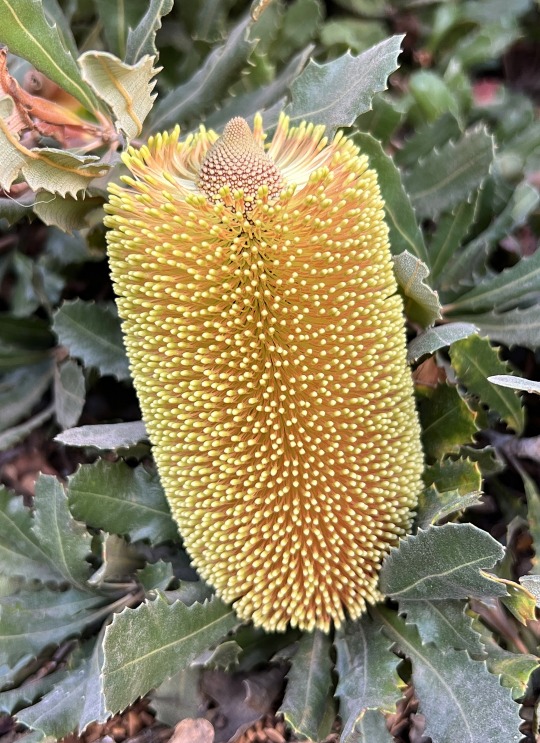
Banksia media
Banksia is a large Australian genus in the Protea Family, and many of the species are found in the winter-rainfall region in the country's southwest. This is the case with Banksia media, which is found along the southern coast of Western Australia. It varies from a ground cover to a small tree, depending on the area where it grows, but mostly it is a rounded bush, putting out its cylindrical clusters of flowers during the winter months. The middle photo shows a young flower head, while the lower photo shows one at maturity. The saw-tooth edges of the leaves are a feature seen in many banksias.
-Brian
36 notes
·
View notes
Text

Ancalagon the Black Purple
(based on the Leafy Sea Dragon, found in southwest western australia)
67 notes
·
View notes
Text










the western arthur range in the southwest national park, lutruwita/tasmania, australia. photographed by dennis rittson 1969 & 1973.
#kodachrome#southwest national park#tasmania#lutruwita#bushwalking#paddy pallin#western arthur range#western arthurs#1970s
5 notes
·
View notes
Text
this entire thing started because @ravenlikesbooks pointed out that one part of florida is in central time and the rest is in eastern btw. things spiraled from there. Anyways things ive learned from looking at different timezone maps of the continents:
asia has the most half-hour timezones and one 3/4 hour timezone (nepal). also asias timezones in general are just like. A mess. It gives me a headache to look at. I love it SO FUCKING MUCH
oceania has several half hour timezones and two 3/4 hour timezones, the most per continent, one in Eucla, Australia SPECIFICALLY for some reason and the other being the Chatham Islands in NZ
there are a total of two half hour timezones in north america, one in canada and the other being greenland! also a lot of full hour timezones in the usa go across state borders. most of indiana is in eastern time but there are two portions in the northwest and southwest corners of the state that are in central. theres a few cases of this. its so strange. i love it.
venezuela is the only country in south america to have a half hour timezone. the rest are in full hour increments. like ok girl go off (?)
the european union obviously has its shit together, because europe is the only continent that has both no half hour timezones and no timezones that cross country borders. i have some questions about why portugal is considered to be in the western european timezone when spain isn't and is grouped in with central european countries such as france and germany, but its not really too big a deal so im willing to let it slide
africa comes in second place for most neatly organized continent in terms of time zones. it would have a perfect timezone score tied with Europe if it werent for the fact that the DRC is split between two, but its whatever.
antartica is also a mess but its antartica so thats to be expected
in summary, here are the seven world continents ranked by order of least to most complicated timezones
Europe
Africa
South America
North America
Oceania
Antartica
Asia
11 notes
·
View notes
Text
[ 📹 Scenes of massive destruction after Israeli Occupation Forces bombed a civilian home belonging to the Abu Awaili family in the al-Habda neighborhood of Deir al-Balah in the central Gaza Strip on Tuesday night.]
🇮🇱⚔️🇵🇸 🚨
💥OCCUPATION BOMBING RAIDS IN CENTRAL GAZA AND INTENSE SHELLING OF KHAN YUNIS ON DAY 116 OF ISRAELI GENOCIDE💥
Bombing and shelling continued for another day and into the night in the Gaza Strip, while at the same time, Palestinian Minister of Health, Mai Alkaila warned of catastrophic healthcare conditions in the outdoor prison that Gaza is.
Speaking in interview with Palestine TV, Minister Alkaila spoke about severe shortages of health personnel, equipment, medicines and open clinics for Palestinians in Gaza, even as the shells continue to rain down on central and southern Gaza, where Israeli forces penetrated deep into the Khan Yunis governate.
“There are 36 hospitals in the Gaza Strip, 14 of which are partially operating, 9 in the south and 5 in the north," Minister Alkaila told Palestine TV.
She warned that a large outbreak has become probable and emphasized the need for vaccines for children, telling Palestine TV that over 1'100 medical personnel were dead or wounded.
Minister Alkaila also warned that the thousands of dead still trapped under the rubble are an environmental disaster waiting to unfold as it can contribute to the spread of disease.
Lastly, Alkaila slammed the various Western countries, including the United States, the UK, Germany and Australia, among others, that have suspended funding to UNRWA over accusations by the Israeli occupation authorities that less than 0.04% of UNRWA's staff might have participated either directly or indirectly in the events of October 7th.
Israel has previously made repeated made false accusations against international agencies and organizations, including the United Nations, as well as having a history of false flags, set-ups, and false confessions extracted through torture.
Meanwhile, the Palestinian Red Crescent Society (PRCS) reported Tuesday that the Israeli Occupation Forces (IOF) stormed the local headquarters of the humanitarian organization, while also raiding the al-Amal Hospital building's front courtyard area in Khan Yunis, southern Gaza.
Reports tell of Occupation tanks and soldiers demanding the evacuation of both locations under threat of weapons, while the IOF use VHF wave suppression to block communications with the outside world.
Israeli tanks in the courtyard of Al-Amal fired live ammunition and lobbed smoke grenades at the displaced Palestinians outside the hospital, while occupation munitions caused several fires to break out within the confines of PRCS HQ.
Red Crescent crews also transported 16 dead, including women and children, as a result of Israeli airstrikes which targeted another civilian home in the city of Deir al-Balah, in the central Gaza Strip.
Medical sources with PRCS also said they'd transported one dead individual and three wounded civilians after occupation warplanes bombed a residential home west of the Nuseirat Camp, in central Gaza. PRCS published video of the scene after its ambulance and civil defense crews arrived at the site of the occupation's bombing raid, with widespread destruction evident in the footage.
Occupation aircraft also targeted the al-Bureij Camp, in the central Gaza Strip, resulting in several casualties, with another airstrike targeting a group of civilians in al-Bureij, wounding several people.
IOF jets also bombed the Nuseirat Refugee Camp in addition to the heavy shelling of the northern sections of Beit Lahia in northern Gaza, as well as the eastern sections of Khan Yunis to the south.
The Israeli occupation army also launched several missiles randomly towards civilian homes, especially in the al-Sina'a neighborhood west of Gaza City.
Gaza City's horrors continued with reports of dozens of bodies littering the streets in the west and southwest of the city after occupation air raids, tanks and drone fire concentrated on the area.
Israeli soldiers also opened gunfire in the vicinity of al-Shifa Medical Complex west of Gaza City, resulting in the death of a Palestinian child.
As a result of Israel's war of genocide in the Gaza Strip, the occupation army committed 13 massacres of Palestinian families, killing 114 people, mostly women and children, with an additional 65'636 Palestinians wounded according to Gaza's Ministry of Health.
#source1
#source2
#source3
#source4
#source5
#videosource
@WorkerSolidarityNews
#gaza#gaza news#gaza war#gaza strip#gaza genocide#genocide in gaza#israeli occupation forces#israel#israeli war crimes#war crimes#crimes against humanity#israeli genocide#genocide#palestine#palestine news#palestinians#war#middle east#israel palestine conflict#politics#news#geopolitics#world news#global news#international news#breaking news#current events#war on gaza#iof#israeli military
16 notes
·
View notes
Text
Holidays 2.5
Holidays
Adlai Stevenson Day (Illinois)
Aerial Victory Day
Angel Conwell Day (South Carolina)
Antigone Asteroid Day
Belle Starr Day
Chama Cha Mapinduzi Day (Tanzania)
Cheongwoldaeboreum (Folk Festival; North Korea)
Crown Princess Mary Day (Denmark)
Disaster Day
Family Leave Bill Day
Georgia Arts Day (Georgia)
Hank Aaron Day
International Clash Day
Kashmir Solidarity Day (Pakistan)
Lailatul Quadr (Night of Power)
Longest War Day (3rd Punic War ended in 1985 after 2,131 years)
Move Hollywood and Broadway to Lebanon, Pennsylvania Day
National Fart Day (a.k.a. Did You Fart? Day)
National Red Solo Cup (Toby Keith)
National Shower with a Friend Day
National Tinnitus Awareness Day
National Weatherperson's Day (f.k.a. Weatherman's Day)
Othroktide (Elder Scrolls)
Pikachu Day
Robert “Bobbie” Peel Day (UK)
Runeberg Day (Finland)
Trayvon Martin Day
Unity Day (Burundi)
Waitangi Dildo Incident Day (New Zealand)
Wiffle Ball Day
Food & Drink Celebrations
Bartender’s Cup
Chocolate Fondue Day
National Rosé Day (Australia; New Zealand)
World Nutella Day
Nature Celebrations
California Western Monarch Day
Fern Day (Lovely; Korean Birth Flowers)
Lichen Day (French Republic)
Primrose Day (Primula acaulis)
Western Monarch Day
World Animal Reiki Day
Independence, Flag & Related Days
Arkazja (Declared; 2022) [unrecognized]
Constitution Day (Mexico)
Liberation Day (From the Alberoni Occupation; San Marino)
1st Wednesday in February
Book Direct Day [1st Wednesday]
Empire State Building Run Up Day [1st Wednesday]
Global School Play Day [1st Wednesday]
Hump Day [Every Wednesday]
National Girls and Women in Sports Day [1st Wednesday]
National Signing Day (College Football) [1st Wednesday]
Wacky Wednesday [Every Wednesday]
Website Wednesday [Every Wednesday]
Wheat Beer Wednesday [1st Wednesday of Each Month]
Wilderness Wednesday [1st Wednesday of Each Month]
Winter Walk Day (Canada) [1st Wednesday]
World Read Aloud Day [1st Wednesday]
Weekly Holidays beginning February 5 (1st Week of February)
US Snow Sculpting Week (thru 2.9)
Festivals Beginning February 5, 2025
Festival Astropolis (Brest, France) [thru 2.9]
Food Processing Expo (Sacramento, California) [thru 2.6]
Southern Farm Show (Raleigh, North Carolina) [thru 2.7]
Southwest Michigan Horticultural Days (Benton Harbor, Michigan) [thru 2.6]
Lunar Calendar Holidays
Chinese: Month 1 (Wu-Yin), Day 8 (Yi-Si)
Day Pillar: Wood Snake
12-Day Officers/12 Gods: Balance Day (平 Ping) [Inauspicious]
Holidays: None Known
Secular Saints Days
Herman Charles Bosman (Literature)
C. E. Brock (Art)
William S. Burroughs (Literature)
Henfil (Art)
H.R. Giger (Art)
Christopher Guest (Entertainment)
Robert Hofstader (Science)
B.S. Johnson (Literature)
Al Kooper (Music)
Jennifer Jason Leigh (Entertainment)
Laura Linney (Entertainment)
Bob Marley (Music)
Charlotte Rempling (Entertainment)
Carl Spitzweg (Art)
Roger Staubach (Sports)
Cory Wells (Music)
David Wiesner (Art)
Festivals Beginning February 5, 2024
Carnival of Oruro (Oruro, Bolivia) [thru 2.14]
New Mexico Chile Conference (Las Cruces, New Mexico) [thru 2.5]
Order of Venus Mob-Chella Mardia Gras Ball (Mobile, Alabama)
Ridgefield Restaurant Week (Ridgefield, Connecticut) [thru 2.11]
Whale Fiesta (San Pedro, California)
Feast Days
Abraamius, Bishop of Arbela (Christian; Martyr)
Adelaide of Vilich (or Bellich; a.k.a. Alice; Christian; Saint)
Agatha of Sicily (Christian; Saint)
Anne Hutchinson (Episcopal Church USA)
Avitus of Vienne (Christian; Saint)
Benedict Arnold Day (Church of the SubGenius; Saint)
Bertulf (a.k.a. Bertulph; Bertoul of Renty; Christian; Saint)
Day of the Serpent (Pagan)
Doodle Day (Pastafarian)
The Fornacalia (Goddess of Furnaces) [until 17th]
The Goat (Muppetism)
Indractus and Dominica (Christian; Martyrs)
Ingenuinus (Jenewein; Christian; Saint)
Jeanne de Valois (Christian; Martyr)
Lantern Festival (China) [15th Day of Chinese New Year]
Martyrs of Japan (Christian; 25 Martyrs, 1597)
Martyrs of Pontus (Christian; Martyrs)
Nones of February (Ancient Rome)
Philip of Jesus (Christian; Saint)
Pirate Garb Day (Pastafarian)
Ragged Young Man, Shaggy Filly & Freckle-Legged Girl Day (Celtic Book of Days)
Roger Williams (Baptist & Episcopal Church USA)
Sacred Maiden Ia Day (Everyday Wicca)
Scopas (Positivist; Saint)
Triodion begins (Eastern Orthodox Christian) [70 Days before Easter]
Twenty-six Martyrs of Japan (Evangelical Lutheran Church in America; Anglican Church in Japan)
Vasant Panchami (Hinduism)
Vodalus (a.k.a. Voel; Christian; Saint)
Weatherperson’s Day (Starza Pagan Book of Days)
Wyrd’s Day (Celtic Goddess of Fortune Telling)
Lucky & Unlucky Days
The Furies Bring Calamity Day (Ancient Greece)
Lucky Day (Philippines) [9 of 71]
Tomobiki (友引 Japan) [Good luck all day, except at noon.]
Premieres
The ABC of Hand Tools (Disney Cartoon; 1946)
The Adventures of Hardrock Dome #2 (Paramount-Bray Pictographs Cartoon; 1919)
Alice in Wonderland in Paris (Animated Film; 1966)
Back Alley Oproar (Blue Ribbon Hit Parade Cartoon; 1955)
Bear Country (Disney Documentary Short; 1953)
Be Mice to Cats (Noveltoons Cartoons; 1960)
Big Cheese Boris or I’d Rather Be Rat (Rocky & Bullwinkle Cartoon, S2, Ep. 96; 1961)
Blue Monday (Captain & the Kids MGM Cartoon; 1938)
The Book Shop (Terrytoons Cartoon; 1937)
Boris Makes His Move or The Miceman Cometh (Rocky & Bullwinkle Cartoon, S2, Ep. 95; 1961)
Chew-Chew Baby (Woody Woodpecker Cartoon; 1945)
The County Fair (Oswald the Lucky Rabbit Cartoon; 1934)
Crazy Heart (Film; 2010)
Daisy-Head Mayzie (Hanna-Barbera Animated TV Special; 1995)
Doctor Bluebird (Color Rhapsody Cartoon; 1936)
Donald’s Diary (Donald Duck Disney Cartoon; 1953)
An Education (Film; 2010)
Epitaph for a Spy: A Spy Thriller, by Eric Ambler (Novel; 1938)
Featuring the Saint, by Leslie Charteris (Short Stories; 1931) [Saint #5]
Felix the Cat in the Oily Bird (Felix the Cat Cartoon; 1928)
Flower in the Hat or The Rose Bowler (Rocky & Bullwinkle Cartoon, S4, Ep. 201; 1963)
The General (Film; 1927)
Glad Rags to Riches (Film; 1933)
Hail, Caesar! (Film; 2016)
Hansel and Gretel (Terrytoons Cartoon; 1933)
Heart of Gold, by Neil Young (Song; 1972)
He Dood It Again (Super Mouse Cartoon; 1943)
Instant Replay, by The Monks (Album; 1969)
Lego Masters (UK TV Series; 2022)
Loaded Weapon (Film; 1993)
Love My Life Away, by Gene Pitney (Song; 1961)
Modern Times (Silent Film; 1936)
Mother and Child Reunion, by Paul Simon (Album; 1972)
Mr. Fuller Pep: He Does Some Quick Moving (Powers Cartoon; 1917)
Mucho Loco (WB MM Cartoon; 1966)
No Deposit, No Return (Film; 1976)
Otello, by Giuseppe Verdi (Opera; 1887)
Patton (Film; 1970)
Peter Pan (Animated Disney Film; 1953)
Pipe Dreams (Happy Harmonies MGM Cartoon; 1938)
Porky at the Crocadero (WB LT Cartoon; 1938)
Presto Change-O (Blue Ribbon Hit Parade Cartoon; 1949)
Pride and Prejudice and Zombies (Film; 2016)
Private 1st Class Norakuro (Norakuro Cartoon; 1935)
Puddy the Pup in the Bookshop (Terrytoons Cartoon; 1937)
Robin Hood, Jr. (Willie Whopper MGM Cartoon; 1934)
RoboCop (Orion Stop Motion Cartoon; 1988)
The Robot (Fleischer Talkartoon Cartoon; 1932)
Scooby-Doo! and the Curse of the 13th Ghost (WB Animated Film; 2019)
She’s Having a Baby (Film; 1988)
The Sidewalks of New York (Fleischer Screen Song Cartoon; 1929)
A Single Man (Film; 2010)
A Snitch in Time or The Finking Man’s Thilter (Rocky & Bullwinkle Cartoon, S4, Ep. 202; 1963)
Southern Exposure (Krazy Kat Cartoon; 1934)
The Spector (Oregon Newspaper; 1846) [1st in Oregon]
String Quartet No. 1 in D Minor, by Arnold Schoenberg (String Quartet; 1907)
Sunday in New York (Film; 1964)
Tau Zero, by Poul Anderson (Novel; 1970)
Tito’s Guitar (Columbia Favorites Cartoon; 1953)
Topsy Turkey (Phantasies Cartoon; 1948)
Travelaugh (Pathé Review; 1921)
Tuxedo Junction, recorded by Glenn Miller (Song; 1940)
Two Happy Amigos (Disney Animated TV Special; 1960)
The Unbearable Lightness of Being (Film; 1988)
Up, by Cardi B (Song; 2021)
Ups ’n’ Downs (WB LT Cartoon; 1931)
The Wandering Earth (Film; 2019)
What Is Life? with Mind and Matter and Autobiographical Sketches, by Erwin Schrödinger (Philosophy Book; 1944)
Why Adam Walked the Floor (Tony Sarg’s Almanac Cartoon; 1922)
Zoo-Illogical Studies (Keen Cartoon; 1917)
Today’s Name Days
Agatha, Albuin (Austria)
Agata, Dobrila, Goran, Jagoda (Croatia)
Dobromila (Czech Republic)
Agathe (Denmark)
Aet, Agaate, Aita, Ita, Iti (Estonia)
Asser (Finland)
Agathe (France)
Agathe, Albuin (Germany)
Agathe, Agathi (Greece)
Ágota, Ingrid (Hungary)
Agata (Italy)
Agate, Agra, Ardis, Selga, Silga (Latvia)
Agota, Birutė, Gaudvinas, Ilona (Lithuania)
Agate, Ågot (Norway)
Adelajda, Aga, Agata, Albin, Izydor, Jakub, Jan, Justynian, Paweł, Piotr, Strzeżysława (Poland)
Agata (Romania)
Agáta (Slovakia)
Ágata, Águeda, Felipe (Spain)
Agata, Agda (Sweden)
Agatha (Ukraine)
Agatha, Chanel, Chanelle, Chantel, Phoenix, Shantel (USA)
Today’s National Name Days
National Leo Day
Today is Also…
Day of Year: Day 36 of 2025; 329 days remaining in the year
ISO Week: Day 3 of Week 6 of 2025
Celtic Tree Calendar: Luis (Rowan) [Day 16 of 28]
Chinese: Month 1 (Wu-Yin), Day 8 (Yi-Si)
Chinese Year of the: Snake 4723 (until February 17, 2026) [Ding-Chou]
Coptic: 28 Tubah 1741
Druid Tree Calendar: Poplar (Feb 4-8) [Day 2 of 5]
Hebrew: 7 Shevat 5785
Islamic: 6 Sha’ban 1446
Julian: 23 January 2025
Moon: 50%: 1st Quarter
Positivist: 8 Homer (2nd Month) [Scopas)
Runic Half Month: Elhaz (Elk) [Day 15 of 15]
Season: Winter (Day 47 of 90)
SUn Calendar: 6 Gray; Sixthday [6 of 30]
Week: 1st Week of February
Zodiac:
Tropical (Typical) Zodiac: Aquarius (Day 17 of 30)
Sidereal Zodiac: Capricorn (Day 22 of 29)
Schmidt Zodiac: Capricorn (Day 11 of 27)
IAU Boundaries (Current) Zodiac: Capricorn (Day 17 of 28)
IAU Boundaries (1977) Zodiac: Capricornus (Day 18 of 28)
2 notes
·
View notes
Text
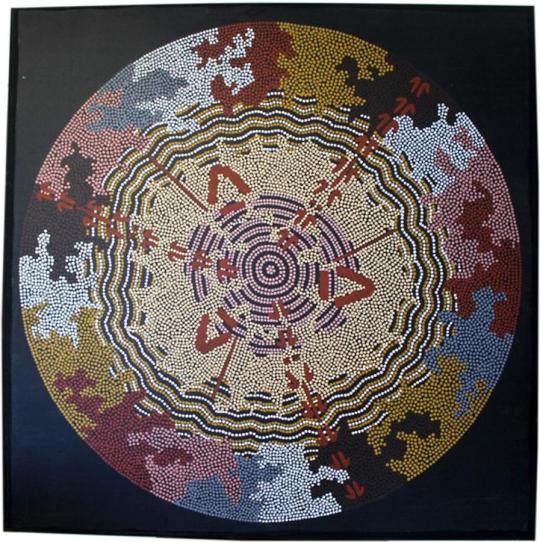
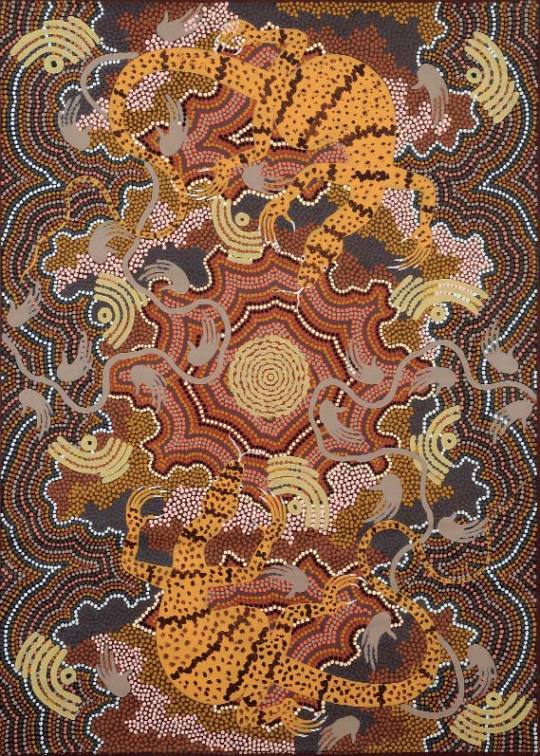
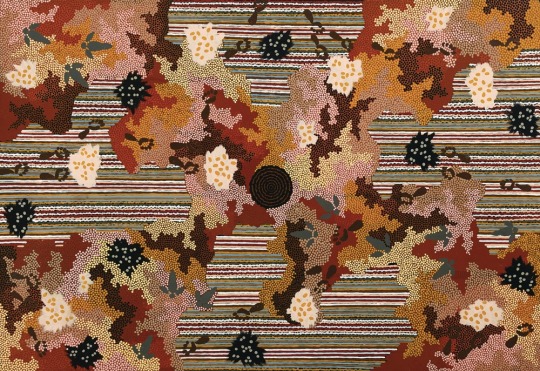


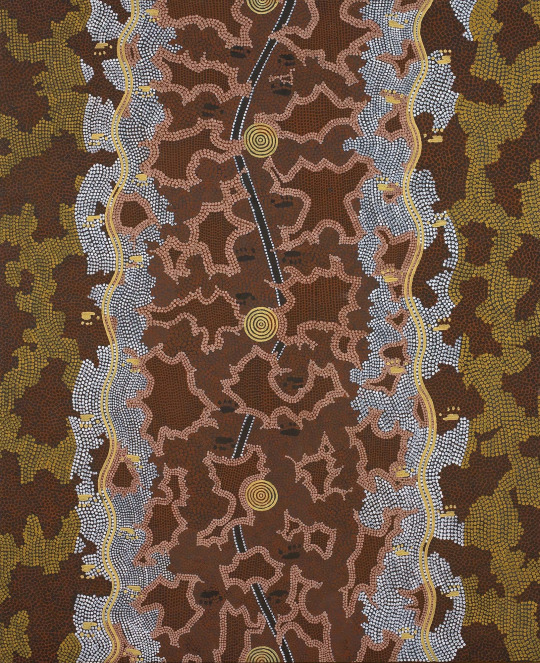



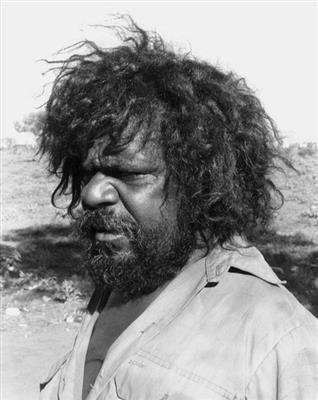
Clifford Possum Tjapaltjarri (c 1932 - 2002) was born in Tjuirri, an area north west of Alice Springs also known as Napperby Station. His father was born at Ngarlu, a location west of Mt. Allan, and his mother from Warlugulong, an area southwest of Yuendumu. This broad stretch of territory defined the diversity of subject matter in Clifford's paintings. Clifford enjoyed a traditional bush upbringing and was given the name Possum by his paternal grandfather. In the 1940's, Clifford and his family re-located to Jay Creek, where he became a stockman, working at several stations throughout the area.
Clifford Possum was said to be a true master artist, his character, charisma, and total dedication to his art and dreamings, as well as his tireless promotion of his and his family's work has set a high standard in establishing this movement from its inception to the present day. Art lovers and collectors, both here and around the world, have held the Desert Masters in high regard, because of the efforts by individuals such as Clifford.
Clifford passed away in Alice Springs on the 21st June 2002, after recently being recognised for his contribution to Australian Art and culture, by being made an "Officer of the Order of Australia". His final days were spent at the Hetty Perkins Nursing Home in Alice Springs, where he passed away surrounded by close family and friends. He will be sadly missed by those who worked with and knew him well, as well as art collectors and dealers around the world.
He worked extensively as a stockman on the cattle stations in and around his traditional country. During this time he developed an encyclopaedic knowledge of the Dreaming Trails that criss-cross the area to the north of the western McDonnell Ranges, which he depicts in painting his Dreamings.
His career as an artist began in the 1950's when he carved snakes and goannas. By the 1970's he was one of the most accomplished carvers in Central Australia. His first opportunity to paint came when one of Albert Namatjira's sons gave him acrylic paints and the master began his work. Clifford, living at the Papunya Community, was one of the first artists to be involved with the Aboriginal Art Movement.
The art of Clifford Possum is notable for its brilliant manipulation of three-dimensional space. Many of his canvasses have strong figurative elements which stand out from the highly descriptive background dotting. In the late 1970's he expanded the scope of Papunya Tula painting by placing the trails of several ancestors on the same canvas in the fashion of a road map. Within this framework, he depicted the land geographically. This laid the foundation for traditional Aboriginal Iconography to be placed on canvas. The other artists working with him took his lead and removed any elements of European Art from their work. In doing so Clifford, as well as the other artists involved with the Papunya Tula Movement, helped to develop the true definition of Aboriginal Art, an art revolving around a culture, The Jukurrpa.
In some of his stories Clifford attempts to give a visual impression of sunlight, cloud, shadow and earth to denote specific times of the day. His paintings show superlative skill, incredible inventiveness of form and are visually spectacular.
Clifford's work is contemporary but essentially Aboriginal in inspiration. To appreciate its full richness it is imperative that it is seen not only by its colour, composition and balance, but by its mythological detail. One of the extraordinary qualities of Clifford's work and other Western Desert artists is that they are a visual writing and speak to the Aboriginal as books do to Europeans.
When asked why he became an Artist, he answered,
"That Dreaming been all the time. From our early days, before European people came up. That Dreaming carry on. Old people carry on this law, business, schooling for the young people. Grandfather and grandmother, uncle and aunty, mummy and father, all that, they been carry on this, teach 'em all the young boys and girls. They been using the dancing boards, spear, boomerang all painted. And they been using them on body different times.
Kids, I see them all the time, painted. All the young fellas they go hunting and the old people there, they do sand painting. They put down all the story, same like I do on canvas. All the young fella they bring 'em back kangaroo. Same all the ladies, they been get all the bush fruit, might be bush onion, plum, might be honey ants, might be yala, all the kungkas (women) bring them back. Because everybody there all ready waiting. Everybody painted. They been using ochres all the colours from the rock. People use them to paint up. I use paint and canvas that's not from us, from European people. Business time we don't use paints the way I use them, no we use them from rock, teach 'em all the young fellas."
Clifford is one of the most renown Aboriginal Artists of his time. He was the chairman of the Papunya Tula Artists from the 1970's to the 1980's. His work is featured in many of the main galleries and collections around Australia and internationally. Collections include the National Gallery of Australia in Canberra and the New South Wales Art Gallery in Sydney. His work has travelled extensively around the world, including 'Dreamings - The Art of Aboriginal Australia' in New York, Chicago, Los Angeles and St Louis. He has had a book published dedicated to him and his paintings, 'The Art of Clifford Possum Japaltjarri', by Vivien Johnson. He is and has always been regarded as the leading figure in Australian Aboriginal Art.
Copyright Kate Owen Gallery May 2022
22 notes
·
View notes
Text
Giant Marri Trees Are Secret Saviours of Western Australias Native Bees
Giant Marri Trees Are Secret Saviours of Western Australia’s Native Bees https://ift.tt/hgiXN1M Are certain species ‘keystones’ for an environment, without which the populations of many other species would collapse? Pendergast & Willers examined the Marri tree (Corymbia calophylla) in western Australia. They examined 16 locales, to see how bees use them. They found that Marri trees bloom when most other plants have finished flowering, making them essential for bee survival. This is a pretty clear indication that any conservation of the bee species has to include a plan for conserving the trees. It’s hard to overstate how important the trees are to the bees. Pendergast & Willers found 81 different species of native bees visiting Marri flowers. In most places studied, about 90% of all bees observed were feeding on Marri trees. In a press release Dr Kit Prendergast added: “Furthermore, this tree not only provides food sources for native bees, but also nesting resources, with species observed nesting in small holes and among the roots, and its copious iconic red sap is used by Megachilidae bees to seal off their nests.” Pendergast & Willers first studied 16 different sites including nature reserves, urban bushland, and forest areas. They then included data from 8 more urban sites studied during earlier research. At each location, they spent 2-3 hours catching bees visiting the trees, using special nets, and identified them under microscopes. Australia has over 1,600 known species of native bees, with at least 500 more yet to be discovered. Most bee conservation work in the Northern Hemisphere focuses on planting flower strips, but in Australia, flowering trees are more important. Native bees and their plant relationships in Australia have evolved over thousands of years in isolation. The study also revealed Marri trees are often the main, or only, plant species visited by these bees year-round, making them indispensable in the local ecosystem, which underlines the importance of conserving this species, not just for bees, but for the health of the broader landscape. “The findings point to an urgent need to protect Marri trees from threats such as logging, mining, fire events, disease, agriculture and urban and industrial development, because without this tree, many native bee species would struggle to survive,” Dr Prendergast said. Prendergast, K.S. & Willers, N. 2024. Corymbia calophylla (Marri) (K. D. Hill & L. A. S. Johnson) (Myrtaceae) is a major resource for native bees in the southwest western Australian biodiversity hotspot. Pacific Conservation Biology. https://doi.org/10.1071/PC24054 (OA) Cross-posted to Bluesky, Mastodon & Threads. The post Giant Marri Trees Are Secret Saviours of Western Australia’s Native Bees appeared first on Botany One. via Botany One https://botany.one/ October 29, 2024 at 08:30PM
2 notes
·
View notes
Text


Quillworts in a gnamma hole in Western Australia
A gnamma hole is a depression formed in granite or other very hard and inert rock that is formed from chemical weathering over millions of years, the name comes from noongar languages of the indigenous peoples of the southwest of Western Australia. Whilst restricted to tiny areas very distantly spaced, Quillworts are relatively easy to find in Western Australia, if you visit the right outcrops at the right time of year you will see them reliably every time.
It is not easy to identify a quillwort to a species in Western Australia without destructively collecting and dissecting a specimen as all the currently described species overlap significanty in morphology depending on growing conditions.
If you want to see a quillwort IRL and are willing to travel to Western Australia let me know because I can provide directions and coordinates or meet IRL because the extreme biodiversity in flowering plants here in SouthWest WA means the little quillworts get overlooked even by the most passionate of botanists.
This gnamma hole was in a ~1.5 billion year old granite bedrock outcropping in Cape Le Grande near Esperance https://www.inaturalist.org/observations/171702188
2 notes
·
View notes
Text
Interview with Sara Foster and When She Was Gone
Blackstone Pub
April 1st, 2025
When She Was Gone by Sara Foster brings to the forefront the unusual relationship between a mother and her daughter. This intertwined within a riveting mystery allows readers to understand the mother/daughter dynamics.
Former Detective Rose Campbell who now lives in London is notified that her estranged daughter, Lou, has disappeared from a remote Western Australian beach. They have not spoken in years because of how Lou’s father and stepmother spoke of Rose. Yet, now Rose’s ex, Henry, has called on her to help find their daughter who is suspected of kidnapping the two young children she is the au pair for. The missing baby and toddler are heirs to a high profile and wealthy Australian family, the Fishers. Rose is intent on finding her daughter and proving her innocence.
The detective assigned to the case, DSS Mal Blackwood, on the verge of retirement, is chosen because of his ability to solve some of the most intense and difficult investigations. At first, Rose and Blackwood appear at odds as to what really happened but that all changes when a disturbing piece of evidence is found on a nearby strip of beach, making it clear that they are caught in a race against time to bring Louisa and the children safely home.
This is a very suspenseful novel that readers will not want to put down with well-defined characters that they will either root for or hate.
Elise Cooper: Idea for the story?
Sara Foster: When She Was Gone came about because I wanted to write a story set in Western Australia, where I live with my family, and so I began dreaming up different thriller ideas. The remote beaches of the southwest are some of my favorite places, and I also like writing about characters with connections to both England and Australia (like me!). Once I had the au pair character of Louisa, and her estranged mother Rose, the rest of the story began to fall into place.
EC: Was the theme retribution, power, money?
SF: I think all the themes of retribution, power and money come into play at different times in When She Was Gone. Power and money are certainly deeply interconnected in this story. Money gives some characters the opportunity to act in ways that others simply cannot with those who don’t have money are much more limited in their choices.
EC: How would you describe the mystery in the story and what was its role?
SF: The central mystery of When She Was Gone is the disappearance of Louisa (Lou) and the children, and this thread runs right through the book. I hope the reader is absorbed in the thriller elements of the story and the way this event has repercussions for so many people
EC: Is domestic violence the center of the story?
SF: I don’t think of domestic violence as the singular center of the story but it’s certainly a core thematic element of the novel. I wanted to look at violence in all its forms. Latent as well as actualized – and to think about how violent tendencies develop when early signs aren’t addressed.
EC: Why this domestic violence book quote, “By the time a victim has been degraded, undermined, and attacked for years, they have lost all sense of control. They exist from one terrified moment to the next, sometimes for years, and reclaiming their lives is a messy, protracted process.”
SF: I think it’s all too easy to judge domestic violence victims without stepping into their shoes, whereas there are many reasons why it’s hard to leave an abusive relationship. I hope my story exposes the complexity and messiness of these scenarios and encourages empathy rather than judgement.
EC: How would you describe Rose?
SF: By the time we come to meet Rose in When She Was Gone, she has gone through a terrible period of grief and depression after a traumatic work event as a young police officer, which readers’ witness at the beginning of the book, leaving her with PTSD. However, she has come through this, rebuilt her career, and is in a much stronger place by the time she needs to search for her missing daughter Louisa.
EC: How would you describe Henry?
SF: Henry, Rose’s husband, has been emotionally abusive to Rose over the years, withholding access to Louisa, making life generally difficult for her, and always putting himself first. This changes when Louisa disappears just as his third wife has given birth to twins, meaning Henry is unable to fly to Australia himself, and must therefore appeal to Rose to help him. He is a bit of a classic, self-centered, and narcissist.
EC: How would you describe Louisa?
SF: We don’t get to see much of Louisa directly in the story, only briefly at the beginning before she disappears with the children, at which point she’s obviously unhappy with the way the Fishers treat her and parent their kids. However, once she’s gone, we can only learn about her through secondary sources – her diary, her Instagram, and other people’s accounts. Through this we can see her strength and her vulnerabilities, and Rose must pray that Louisa is worldly enough to keep herself together in whatever situation she’s in.
EC: How would you describe the Fishers?
SF: The two young children who disappear with Louisa belong to a very wealthy family called the Fishers, who are used to getting their own way or using their considerable wealth to turn events to their favor. However, when these two very small Fisher children go missing, and no one has any idea what’s happened, for once money cannot buy the family out of this predicament, and they are forced to try to communicate with one another in different ways.
EC: Anything else you would like to add?
SF: I write weekly on Substack at The Resiient Author (for writers) and Story Matters (for readers).
EC: Next books?
SF: I’m working on another mystery thriller now with a few more puzzle elements to it, set in the Cotswolds in the UK, a place my grandparents lived for a while. I’m having a lot of fun refining the characters and plot, as I try to bring it all together.
THANK YOU!!
0 notes
Text
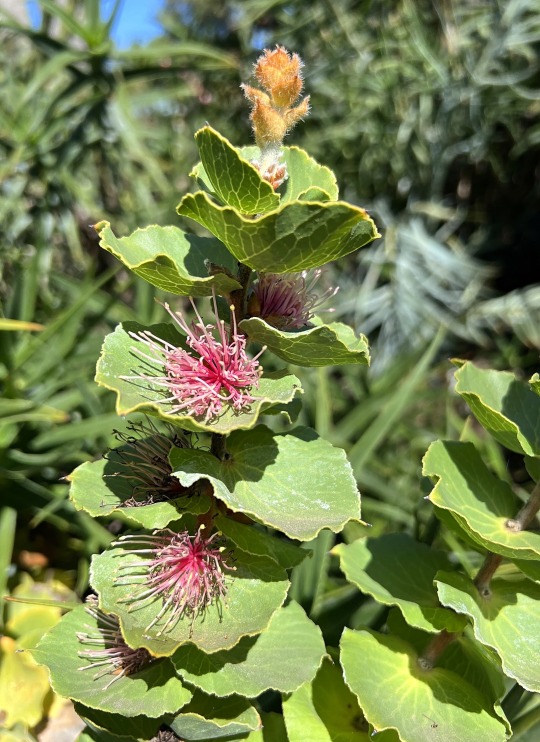
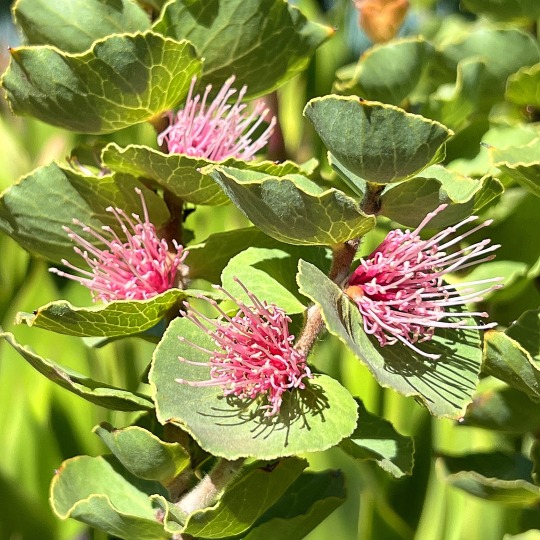
Hakea cucullata
Hakea is a large genus in the Protea Family native to Australia. Though different species are found in various part of the country, the greatest concentration occurs in the southwest, in the winter-rainfall region. This is true for Hakea cucullata, which comes from the south coast of Western Australia, to the southeast of Perth. It is a large shrub, eventually attaining a height of up to 13 feet, or 4 m. The clusters of pink flowers, with extended stigmas, are not large, but they are quite attractive - and all the more appealing for they way they are cupped by the rounded wavy-edged leaves.
-Brian
56 notes
·
View notes
Text

elrond and elros on a trip to a beach in sirion
Based on The Other Side of the Moon, in southwest western australia, which I would highly recommend visiting if you're able to.
11 notes
·
View notes
Text

Why You Should Join Pinnacle Taekwondo in Sydney? Are you looking for a fun, empowering, and fitness-boosting activity for yourself or your child in Sydney? Pinnacle Taekwondo offers more than just martial arts training—it provides a path to confidence, discipline, and lifelong health. 1. World-Class Instructors At Pinnacle Taekwondo Sydney, you're guided by some of Sydney’s most experienced and passionate martial arts instructors. With national and international credentials, they combine modern sports science with traditional Taekwondo principles to ensure safe and effective training for students of all ages. 2. Programs Tailored to All Ages and Skill Levels Whether you’re a complete beginner or a seasoned martial artist, Pinnacle Martial Arts has a program to match your needs: - Mini Rangers Program (for ages 3–6): Focuses on motor skills, balance, and basic discipline. - Martial Rangers Program (for ages 7-12): Builds confidence, focus, and self-defense skills in a fun, supportive environment. - Teens & Adults Program: A great way to stay fit, learn self-defense, and relieve stress while training with like-minded peers. 3. Focus on Confidence, Discipline & Leadership Taekwondo Martial Arts isn’t just about kicks and punches. Pinnacle’s curriculum emphasizes personal growth. Students learn goal setting, respect, responsibility, and resilience—skills that transfer into school, work, and everyday life. 4. A Safe and Family-Friendly Environment Parents love Pinnacle Taekwondo in Sydney for its supportive and welcoming environment. Classes are run with a strong emphasis on safety, and the team goes above and beyond to make every student feel like part of the family. 5. Proven Track Record of Success Pinnacle Taekwondo Sydney students consistently achieve their belt goals and excel in competitions across Australia. The academy’s structured training system ensures progress while keeping classes engaging and dynamic. 6. Convenient Locations Across Sydney With multiple Taekwondo training locations in Sydney, Pinnacle offers flexibility and accessibility for busy families. Whether you're in Marrickville Inner West, Earlwood Canterbury area, Chester Hill Bankstown area, Caddens in Penrith area Sydney, or nearby suburbs, there’s likely a class close to you. 7. Try Before You Commit Pinnacle Taekwondo in Sydney offers free trial classes, so you or your child can experience the program firsthand with no obligation. This makes it easy to find out if the school is the right fit for your goals. Final Thoughts Joining Pinnacle Taekwondo in Sydney isn’t just about learning self-defense; it’s an investment in personal growth, health, and community. Whether you're aiming to improve your fitness, learn discipline, Self Defence, or give your child a positive head start in life, Pinnacle Taekwondo stands out as one of Sydney’s top martial arts schools. Ready to kickstart your journey? Book a free trial and take the first step toward becoming your best self. 🥇 Sign Up for the Best Martial Arts Classes Near You! 📞 Call us: 0410 686 585 📩 Email: [email protected] 🌐 Website: pinnaclemartialarts.com.au 📍 Book Now: Book A Free Class Follow us for updates and training tips! 👍 Facebook | 📸 Instagram Our Locations 📍 Pinnacle Karate Martial Arts Marrickville (Headquarters) 23 Yabsley Ave, Marrickville, Inner West Sydney 📍 Pinnacle Taekwondo Martial Arts in Chester Hill 12 Banool St, Chester Hill, Bankstown Area, Southwest Sydney 📍 Pinnacle Taekwondo Martial Arts in Penrith Penrith Baptist Church, Morello Terrace, Caddens, Western Sydney 📍 Pinnacle Karate Martial Arts in Earlwood (Canterbury Bankstown Area) Martial Arts, Fitness, and Self-Defence Programs Across Sydney Read the full article
0 notes
Text
Perth
This week we are looking at the last of Australia’s capital cities and that city is Perth, capital of Western Australia. It sits where the Swan River meets the southwest coast. Sandy beaches line its suburbs, and the huge, riverside Kings Park and Botanic Garden on Mount Eliza offer sweeping views of the city. The Perth Cultural Centre houses the state ballet and opera companies, and occupies its…

View On WordPress
0 notes
Photo
I use the state abbreviation WA to seek shots for this blog. Until this one cropped up, I had forgotten that WA also means Western Australia. I am posting this rather interesting scene of Australia's Indian Ocean Southwest even if it is quite out of place.

Kwinana, WA. December, 2016.
174 notes
·
View notes